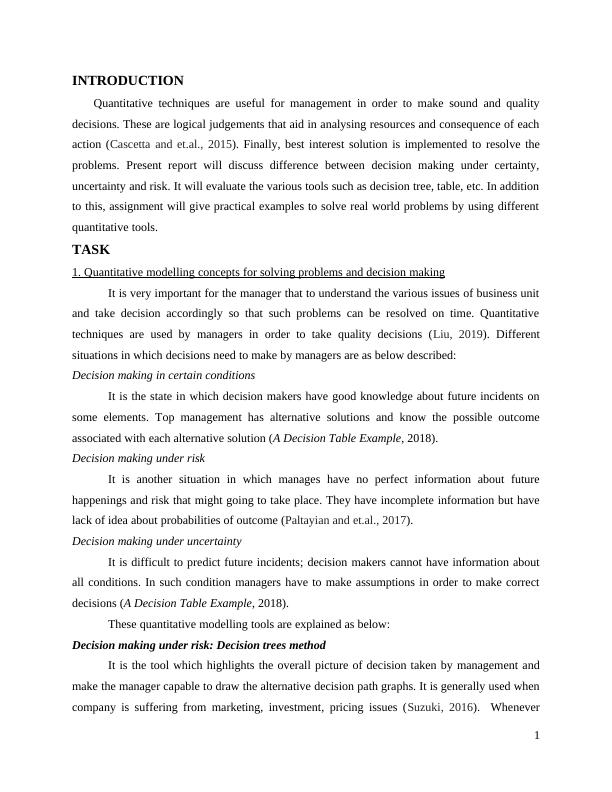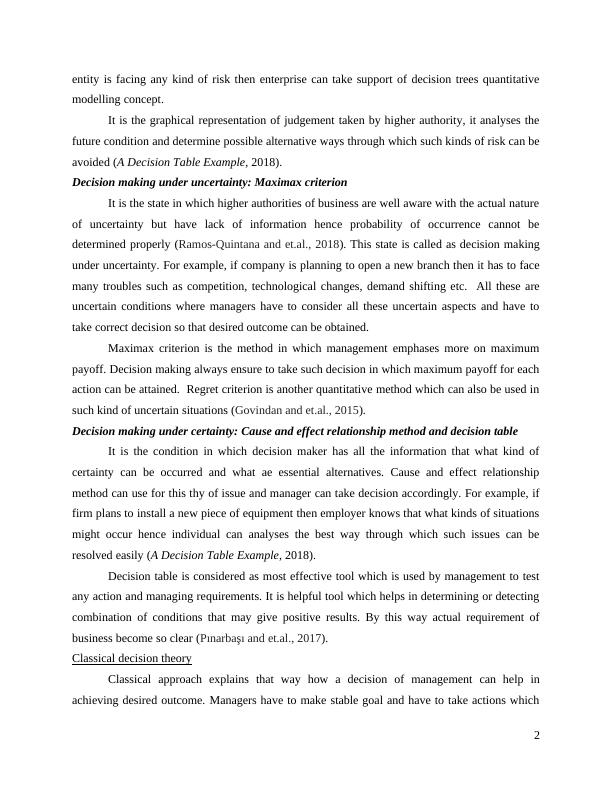Effective Problem Solving and Decision Making
13 Pages2630 Words44 Views
Added on 2021-02-21
Effective Problem Solving and Decision Making
Added on 2021-02-21
ShareRelated Documents
DECISION MAKING

TABLE OF CONTENTSINTRODUCTION...........................................................................................................................1TASK...............................................................................................................................................11. Quantitative modelling concepts for solving problems and decision making.........................1Classical decision theory.............................................................................................................2Logical process of modelling complex decision problems..........................................................3Apply techniques to real-world problems....................................................................................4Solution of problem by using excel.............................................................................................8CONCLSUION................................................................................................................................9REFERENCES..............................................................................................................................10

INTRODUCTIONQuantitative techniques are useful for management in order to make sound and qualitydecisions. These are logical judgements that aid in analysing resources and consequence of eachaction (Cascetta and et.al., 2015). Finally, best interest solution is implemented to resolve theproblems. Present report will discuss difference between decision making under certainty,uncertainty and risk. It will evaluate the various tools such as decision tree, table, etc. In additionto this, assignment will give practical examples to solve real world problems by using differentquantitative tools.TASK1. Quantitative modelling concepts for solving problems and decision makingIt is very important for the manager that to understand the various issues of business unitand take decision accordingly so that such problems can be resolved on time. Quantitativetechniques are used by managers in order to take quality decisions (Liu, 2019). Differentsituations in which decisions need to make by managers are as below described:Decision making in certain conditionsIt is the state in which decision makers have good knowledge about future incidents onsome elements. Top management has alternative solutions and know the possible outcomeassociated with each alternative solution (A Decision Table Example, 2018).Decision making under riskIt is another situation in which manages have no perfect information about futurehappenings and risk that might going to take place. They have incomplete information but havelack of idea about probabilities of outcome (Paltayian and et.al., 2017). Decision making under uncertaintyIt is difficult to predict future incidents; decision makers cannot have information aboutall conditions. In such condition managers have to make assumptions in order to make correctdecisions (A Decision Table Example, 2018). These quantitative modelling tools are explained as below:Decision making under risk: Decision trees methodIt is the tool which highlights the overall picture of decision taken by management andmake the manager capable to draw the alternative decision path graphs. It is generally used whencompany is suffering from marketing, investment, pricing issues (Suzuki, 2016). Whenever1

entity is facing any kind of risk then enterprise can take support of decision trees quantitativemodelling concept.It is the graphical representation of judgement taken by higher authority, it analyses thefuture condition and determine possible alternative ways through which such kinds of risk can beavoided (A Decision Table Example, 2018).Decision making under uncertainty: Maximax criterionIt is the state in which higher authorities of business are well aware with the actual natureof uncertainty but have lack of information hence probability of occurrence cannot bedetermined properly (Ramos-Quintana and et.al., 2018). This state is called as decision makingunder uncertainty. For example, if company is planning to open a new branch then it has to facemany troubles such as competition, technological changes, demand shifting etc. All these areuncertain conditions where managers have to consider all these uncertain aspects and have totake correct decision so that desired outcome can be obtained. Maximax criterion is the method in which management emphases more on maximumpayoff. Decision making always ensure to take such decision in which maximum payoff for eachaction can be attained. Regret criterion is another quantitative method which can also be used insuch kind of uncertain situations (Govindan and et.al., 2015). Decision making under certainty: Cause and effect relationship method and decision tableIt is the condition in which decision maker has all the information that what kind ofcertainty can be occurred and what ae essential alternatives. Cause and effect relationshipmethod can use for this thy of issue and manager can take decision accordingly. For example, iffirm plans to install a new piece of equipment then employer knows that what kinds of situationsmight occur hence individual can analyses the best way through which such issues can beresolved easily (A Decision Table Example, 2018).Decision table is considered as most effective tool which is used by management to testany action and managing requirements. It is helpful tool which helps in determining or detectingcombination of conditions that may give positive results. By this way actual requirement ofbusiness become so clear (Pınarbaşı and et.al., 2017). Classical decision theoryClassical approach explains that way how a decision of management can help inachieving desired outcome. Managers have to make stable goal and have to take actions which2

End of preview
Want to access all the pages? Upload your documents or become a member.
Related Documents
Quantitative Risk Assessment (QRA)lg...
|3
|720
|205
Qualitative and Quantitative Assessment of Riskslg...
|5
|1076
|283
Discussion 1: Decision Treeslg...
|4
|629
|232
Performance Management Report - Doclg...
|6
|1367
|41
Risk Assessment & Management Essaylg...
|10
|3196
|31
Business Research: Definition, Methods, Types and Exampleslg...
|5
|1201
|34
